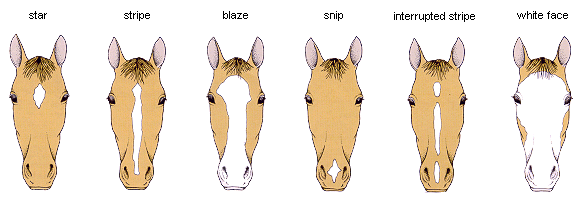
HORSE COLOR, MARKINGS & COMMON HORSE DEFECTS
Please select from the following:
Horse Colors | Horse Markings | Common Horse Defects |
COLORS
Bay: The coat colour can vary
from reddish to brown or yellowish with a black mane, tail and points, i.e. limbs
Black: The coat is all black except for
occasional white marks on the head and/or the legs.
Blue Roan: A black or brown body colour with
white hair giving a blue shade.
Brindle: A coat with brown or grey streaks
or patches in a darker colour.
Brown: The colour brown is a combination of
black and brown hairs with black limbs, mane and tail. A very dark brown may appear as
almost black.
Chestnut: The
colour varies from a pale gold to a rich red gold. The mane and tail are usually lighter
or darker than the coat colour.
Cream or Cremello: A cream coloured coat with unpigmented skin.
Dappled: A light grey base coat with dark
grey rings.
Dun: A dark skin with a light sandy coloured coat with a black mane and tail but can
also range from yellow to mouse colour depending on the diffusion of the pigment. The
colour is often accompanied by dark, dorsal eel stripes extending from the line of the
neck to the tail. There can also be stripes on the withers and legs.
Fleabitten Grey: A grey coloured coat flecked with brown specks.
Grey:
The colour grey is a combination of black and white hairs. The coat
varies from light to iron to very dark.
Liver Chestnut: Liver chestnut is the darkest of the chestnut shades.
Palomino: A gold coloured coat with a white mane and tail.
Piebald: A coat with large, irregular patches of black and white hair.
Roan: A certain body colour infused with white hairs, which lighten the overall effect.
Skewbald: A coat with large, irregular patches of white and any
other colour hair except black.
Sorrel: A light red chestnut coat.
Spotted:
Small, circular patches of hair of a different colour from the main
body colour scattered over various areas of the body.
Strawberry Roan: A chestnut body colour with white hair giving a pinkish
red shade.
MARKINGS
White Markings:
White spots on the face and legs and occasionally on the body. They are recorded on
registration papers as they are a valuable means of distinguishing one horse from
another.
Facial Markings:
Markings in the face include star, stripe, interrupted stripe, snip, blaze, white face and
white muzzle.
Leg Markings:
Leg markings are described in detail for registration purposes, they include white to
fetlock, white to knee, white to hock; sock - white colouring from the coronet to the
knee; stocking - white colouring from the coronet up to and over the knee or hock.
Hoof Colouring:
The horn of the hoof varies in colour from black to blue to white and is often marked with
dark stripes.
 |
 Photos supplied by Horse Directory Australia © |
COMMON DEFECTS
Back at the knee:
The knees tend to extend backwards when viewed from the side.
Calf knees: The
knees are shallow from the front to the back.
Cow hocks: The
hocks turn inwards when viewed from behind (like the hocks of a cow).
Ewe neck: The
top line of the neck is concave and the lower line of the neck is convex.
Herring gutted: The
horse has an upward slope from the front to the back on the underside of the belly.
Over at the knee: The
knees extend forward.
Pigeon toes: The
toes turn inward.
Roach back: The
spine has an exaggerated upward curve.
Sickle hocks:
When viewed from the side there is a concave line in front of the hocks and a slanting
cannon bone.
Slap sided: The
ribs are flat instead of well sprung.
Splay footed:
The toes turn outward.
Sway back: The
back has an exaggerated hollow.
Tied in below the knee:
The measurement of the bone right below the knee is less than the measurement further down
the cannon bone.
![]()